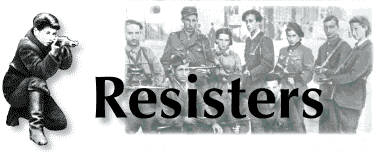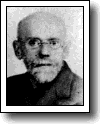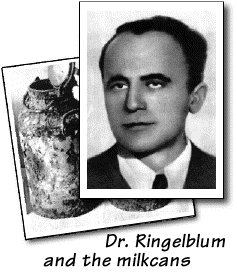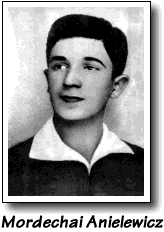
As fear and terror became everyday truths for many Europeans during the Holocaust, standards of daily reality shifted dramatically. The very act of survival became an act of defiance. On February 20, 1941, while living in the Warsaw ghetto, Chaim Kaplan wrote in his diary, "It is almost a mitzvah(an honorable deed) to dance. Every dance is a protest against our oppressors."
Resistance against the Third Reich took many forms. Overt opposition was rarely wise because of the danger of reprisals from the Germans to the community and the constant threats of deportation and on-the-spot death. For example, on December 7, 1941, the Nacht und Nebel(Night and Fog) order was issued to deter resistance by allowing military courts to swiftly sentence resisters to death. Those arrested under this order were said to have disappeared into the "night and fog."
More on the Night and Fog order from the Encyclopedia of the Holocaust.
Unarmed resistance
In the period between WWI and WWII there were many political parties competing for power in Germany. By 1933, Nazis had established themselves in government. It had become dangerous to be a member of any opposition party. Many were beaten and killed for speaking out against Nazism. During the war opposition parties were outlawed and some disintegrated. Others survived and operated clandestinely, transforming themselves into underground resistance organizations. The focus for some shifted to providing food, receiving and transmitting news and information, and boosting morale. Opposition newspapers were forbidden, but almost every underground party published one. The penalty for possession of a radio was death. Yet, for example, in Lodz, an underground group operated a radio listening post for five years.
This site tells the story of The White Rose, a group of students who produced pamphlets resisting the Nazi regime, and paid for it with their lives.
Read "Memories of the White Rose" by George Wittenstein at this Web site.
Jews created an underground economy as a way to resist the Nazis. There were illegal mills and workshops operating for the clandestine marketplace. Smuggling formed a bridge between producers and consumers on both sides of the ghetto walls. Food smuggled into the ghettos was critical for keeping Jews alive. Jews sabotaged the operations of forced labor factories by working slowly or destructively--starting fires or purposefully damaging equipment that they were supposed to be repairing.
A network of Jewish self-help organizations arose out of existing pre-war service groups. In the Warsaw ghetto, these groups offered food at public and children's kitchens, distributed clothing and furniture, provided child care activities, helped refugees find housing, and performed other community work.
 Dr. Janusz Korczak was a pediatrician and the head of an outstanding orphanage in Warsaw. When the children in his orphanage were deported to Treblinka
Dr. Janusz Korczak was a pediatrician and the head of an outstanding orphanage in Warsaw. When the children in his orphanage were deported to Treblinka , Dr. Korczak chose to go with them. He perished there with the children in August, 1942.
Many resources related to the life and work of Janusz Korczak are located here.
Observance of Judaism was illegal, yet during the Holocaust many Jews continued their religious traditions secretly. Community and individual worship, religious study, and religious teaching continued underground. Secular education went underground, too. Throughout German-occupied Europe, small groups of children met daily in makeshift classrooms.
 Historian Emanuel Ringelblum initiated and directed a collection of diaries and documents chronicling the life of Jews in Warsaw during German occupation. He buried the material in crates and milk cans with the hope it would be found after the war.
Historian Emanuel Ringelblum initiated and directed a collection of diaries and documents chronicling the life of Jews in Warsaw during German occupation. He buried the material in crates and milk cans with the hope it would be found after the war.
Entry for Emanuel Ringelblum from the Encyclopedia of the Holocaust.
Jews defied the Nazis in many creative ways. A woman in her seventies, while barely surviving in a concentration camp, wrote a cookbook to pass on to her daughter who had left Europe for Palestine. Inmates in the Theresienstadt concentration camp secretly created art as a form of resistance and as a way to provide evidence of Nazi inhumanity to future generations.
Armed resistance
Eastern Europe, especially Belorussia, the western Ukraine, and Lithuania, had wide expanses of forests and swamps which were ideal for guerrilla warfare. Joseph Stalin called for the establishment of an underground movement in the occupied territories to fight the enemy, and in June 1942, central headquarters were established for the entire partisan movement.
With the influx of Jews into the partisan movement, family camps evolved, especially in Belorussia. These camps ranged from a few families to several hundreds of families. The families took refuge in forests primarily in an effort to save their lives, and secondarily to fight the enemy.
In western Europe, large scale guerrilla movement was impossible due to the more open topography. However, there were acts of organized armed resistance.
In total, partisans were relatively few in number, but because of their ability to move within enemy territory they could disrupt Nazi activity. Partisans interfered with enemy communication by cutting telephone, telegraph, and electrical lines and by destroying power stations. They sabotaged transportation links by blowing up bridges, roads, and railway equipment, and they sabotaged factories that produced materials for the Axis war effort.
Jewish resistance was concentrated in the Polish ghettos of Warsaw, Krakow, Bialystok and Vilna. In the ghettos, two divergent views of resistance emerged. One perspective was that a last stand of honor and vengeance should be shown in the ghetto before its liquidation. The other view was that Jewish armed resisters would do better outside the ghetto, once joined up with the Russian partisans in the woods.
As the sense of death's inevitability became abundantly clear, the youth of the Jewish political movements began to organize armed resistance against the Germans. Such resistance was as much an act of desperation and an open expression of defiance as it was an act of real self-defense. Armed resistance took place within the ghettos and camps, and in collaboration with the resistance "on the Aryan side," which included partisan groups.
Resistance movements needed outside support from allied governments or governments-in-exile. Great Britain and the Soviet Union were the primary sources of resistance support. Arms were also bought from Poles and Russians, at great cost and at enormous risk.
Although there was some armed resistance in several ghettos, Warsaw's insurgency was the most notable. In November, 1942, the Warsaw ghetto-based Jewish Combat Organization (ZOB) was formed. The Warsaw Ghetto uprising began on April 19, 1943, and continued for about a month. Mordechai Anielewicz was the brave commander-in-chief of this armed uprising.
Visit the Resource section to view photographs of the Warsaw Ghetto Uprising.
Visit the Resource section to view a second gallery of photographs documenting the Warsaw Ghetto Uprising.
Many resisters left the ghetto to join partisan groups. They lived in the woods and used weapons that they had stolen or received through governments-in-exile. The ghettos were the recruiting grounds of Jewish partisans. In eastern areas, Jewish youth joined the Soviet partisan movement. Some of the partisan units were all Jewish; many were not.
Resistance continued, even in the death camps. On August 2, 1943, inmates of Treblinka, in an armed revolt, killed SS men and escaped the death camp. Fleeing to the woods, some joined the partisan struggle. On October 14, 1943, an armed revolt took place in Sobibor.
Lastly, there were Jews who were able to disguise themselves as "Aryans" and obtain false papers. They continued the struggle, passing as ordinary couriers, doctors, and civic leaders.
Visit the Resource section to view photographs of resistance groups in the forest, in the ghetto, and even in the death camps.
Visit the Resistance Literature page of the Arts section for an annotated bibliography of recommended works.
The United States Holocaust Memorial Museum publication, Resistance during the Holocaust, describes examples of armed and unarmed resistance by Jewish and non-Jewish Holocaust victims. This 56 page PDF booklet requires Adobe Acrobat for viewing.
This is an in-depth discussion about Jewish prisoner uprisings in the Treblinka and Sobibr extermination camps.
This paper explores the fate of women within the partisan groups living in the forests of what was Eastern Poland.
Dietrich Bonhoeffer, a patriotic German and theologian, opposed Nazism and even participated in a plot to kill Hitler.
The Dietrich Bonhoeffer Home Page offers a biography, bibliography, and links to on-line resources.
Aida Brydbord recounts how she joined a partisan unit and became its nurse.
Fruma Gulkowitz-Berger was the first girl to obtain a rifle and stand guard
in her Jewish partisan unit.
Anna Heilman was one of a small group of young women who obtained gunpowder
used to blow up a crematorium at Auschwitz.
Evelyn Kahn relates what it was like to be a child living among the partisans.
Abba Kovner was a 25-year-old resistance leader in the Vilna Ghetto.
Zenia Malecki describes her role in the United Partisan Organization in the
Vilna ghetto.
Rose Meth smuggled gunpowder for the resistance at Auschwitz.
Jules-Gerard Saliege, Archbishop of Toulouse, resisted anti-Jewish measures and sent a pastoral letter to all of the priests in his diocese demanding recognition of Jews as "brothers."
Rosa Robota organized the smuggling of explosive powder at Auschwitz.
Rosa Robota: Heroine of Auschwitz.
Hannah Szenes was captured, tortured, and executed after parachuting into Yugoslavia
and crossing the border into Hungary in an attempt to rescue Allied prisoners
and her mother.
Biographical sketches of eight female resisters are available at this site.
Interactive quiz on Resisters.
Lesson plans, discussion questions, term paper topics, reproducible handouts, and other resources for teaching about resisters are available here.
Produced by the Florida Center for Instructional Technology,
College of Education, University of South Florida © 1997-2013.
